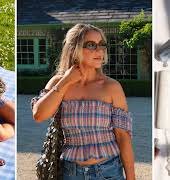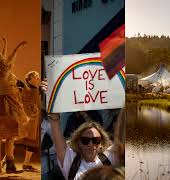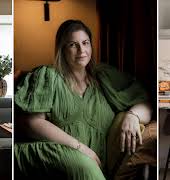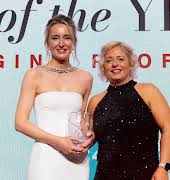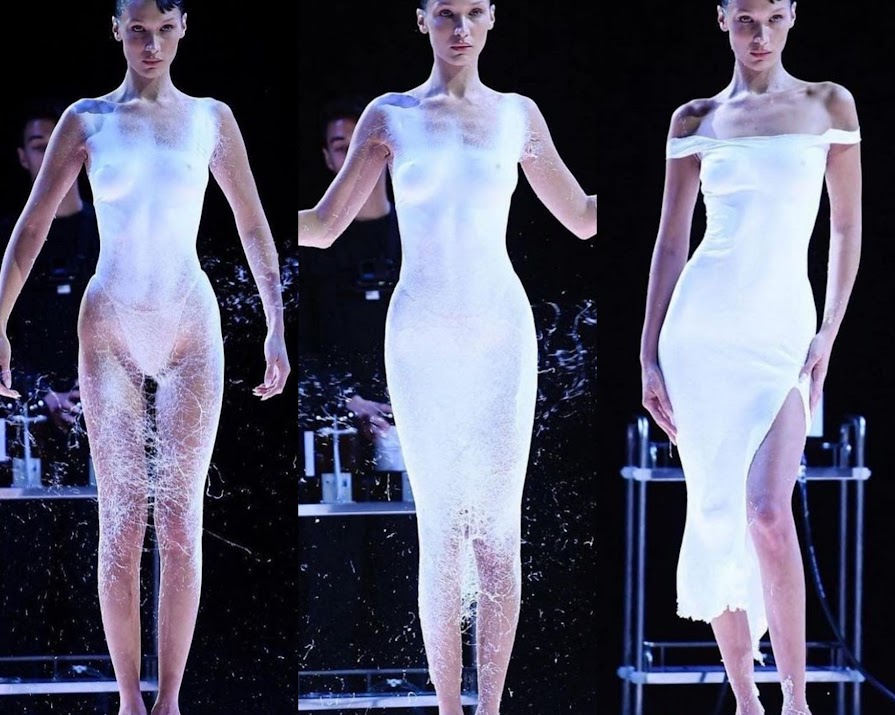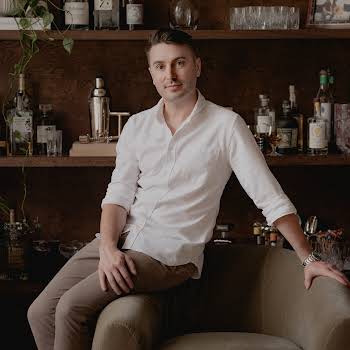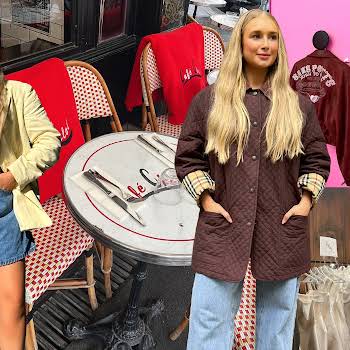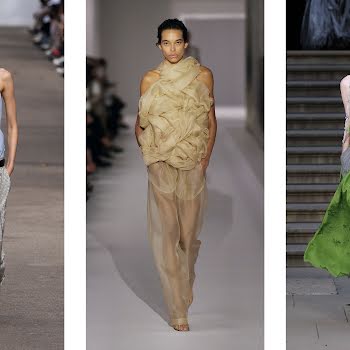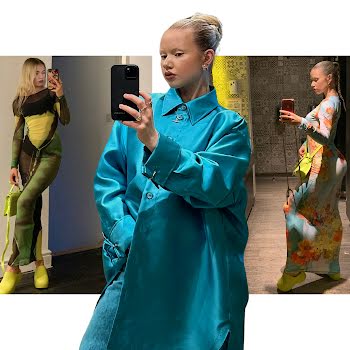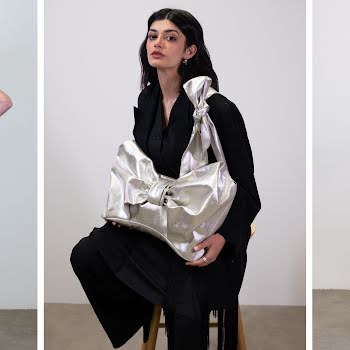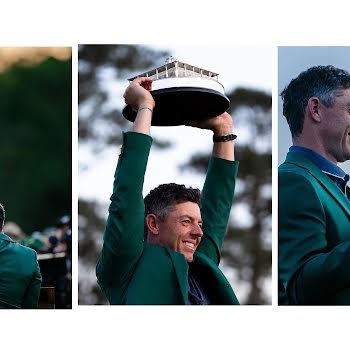
By Paul McLauchlan
14th Oct 2022
14th Oct 2022
By the time Paris Fashion Week concluded on Tuesday afternoon with a tour-de-force show from Nicolas Ghesquière at Louis Vuitton, the weeklong event had witnessed some era-defining moments, excellent collections, and some controversy.
Ye, formerly known as Kanye West, was reproached for his use of ‘White Lives Matter’ slogans on t-shirts at his surprise show on Monday. While the collection itself was served in a muted palette and with the interesting proposition of creating garments that don’t use fastenings or zips and can simply be thrown over your head, the messaging was grotesquely out of touch, easily contextualised and giving power to white-supremacist factions. Ye said he was “at war” but this felt like he waged one. Not to mention him targeting vaunted Black fashion editor, Gabriella Karefa-Johnson who questioned his intentions post-show.
?hl=enMeanwhile, Demna, the mononymous Balenciaga designer and close collaborator of Ye’s, explored ominous themes plaguing society with a mudslide set by artist Santiago Sierra. Every category imaginable made its way down the runway: sportswear, denim, tailoring, eveningwear, and Ye dressed in tactical security attire. Everything is oversized and nothing is overlooked. Nobody can escape this, I inferred. At once, the show felt both out of touch pedalling luxury goods, but so uncomfortably entrenched in the heaviness that society lays witness to nowadays. As many try to look away, Balenciaga, one of the most important luxury brands of the moment, forces you to look. The sense of urgency was unparalleled across all four fashion cities.
From the ongoing war in Ukraine, inflationary pressures, the energy crisis, right-wing forces gaining majority, and escalating civil rights issues in countries like Iran, fashion month took place against a politically loaded backdrop. Sitting at a fashion show in one of the most famous buildings in the world, one is instantly snapped back to reality reading a breaking news report about illegal annexations. Head in the clouds? You can’t have that these days.
It’s why designers like Maria Grazia Chiuri at Dior, and Jonathan Anderson at Loewe, use luxury fashion as a conduit through which they can express sentiments about female empowerment and the state of the world.
In the Jardin du Tuileries, between scattered showers, Chiuri’s hybrid of historicism and modernity was completed with aplomb. Thinking about Catherine de Medici and 16th-century court dress, the Italian designer (who, like Medici, was a transplant in France) considered her inventions: the heeled shoe, the corset, Burano lace. Sure, crinoline dresses embroidered with detailed raffia designs reminiscent of court dresses that took hundreds of hours to complete are the kind of looks reserved for editorials and red carpets, but in the context of nylon jackets with ruched sleeves, embroidered denim jackets, and sweeping trenches, felt fresh. Harking back to the Galliano era, the contemporary appetite for corsets bridged past and present. A history fanatic, this was Chiuri’s finest, most cohesive outing. (Post-show chatter during the week also suggested this was Chiuri’s strongest collection to date.)
?hl=enAt Loewe, with a giant anthurium anchoring the bleached runway space, Anderson pondered what is real and fake. It took the form of anthurium bustiers, shrunken shirt dresses and macs, exaggerated lines, pixellated t-shirts, stretched hoodies with foam inserts, abstracted coats, baggy jeans that are actually supple sweatpants, and distorted eveningwear. In the style playbook of the Irish designer, he rendered everything with finesse. Almost every look was daring, compelling you to focus on it a bit longer, inspect the finer details. In the digital age, people tend not to like to discern what’s real and what’s fake. More often than not, we’re lazy observers happily accepting and digesting information as it’s presented to us. This collection stirred one out of that.
However, not every designer is inclined to offer sweeping statements about the doom and gloom around us. Some of them are concerned with creating really strong clothes, without being beholden to the sign of the times. Is creating good clothes good enough anymore? It’s a challenging, if philosophical, question to ask oneself, and with a discombobulatingly fast news cycle and a jam-packed schedule, you realise that some designers will always stick to their guns.
?hl=enCecilie Bahnsen is one of them. You can count on her for sculptural asymmetric dresses with floral embroideries – this time, she added Japanese denim to the mix, giving proceedings a rawer edge. And let’s not forget about her collaborations with ASICS and Macintosh which reinforce the real-world application of her frothy designs. Hyper-femininity might be the name of the game but a welcome toughness is pervading her work.
Another fan favourite with great merchandise: Nanushka. The Hungarian brand pioneering vegan leather techniques with minimal environmental impact is just as much known for its sustainability efforts as it is for its uber-cool outerwear, this season presented in hues that riff on a sun-bleached photograph. Walking around the showroom in the 8th arrondissement, I don’t want to think how much my wishlist would amount to, from faux leather jackets to exaggerated pilgrim collar shirts, printed denim, and chunky knits.
In a light-filled showroom in the Marais, it was Paul Smith’s turn to try to convince us everything will be alright. With colours recalling the “heat of the summer,” the modest collection still dressed up instead of stripping off with 1980s-inspired louche men’s tailoring and fluid Grecian gowns, jersey column dresses, and oversized trench coats. For a second, you could slip into his perfunctory world with tinges of fantasy.
?hl=en
I’ve noticed that the juncture of past and present has been a focal point in Paris in recent years as some of the city’s fabled maisons re-emerge under the creative helm of younger names. I’m intrigued by Courrèges, known for its Space Age designs, whose designer Nicolas di Felice is charging full speed ahead with a dynamic reinterpretation of house codes that witness the vinyl jackets and party dresses. 1970s disco finds a counterpart in the 2022 beach rave that unfurled in a nondescript studio space on the outskirts of Paris. His clothes are sexy: white shirts with nothing underneath, denim with flesh-baring cutouts; asymmetric slashes on slinky gowns. These days, everybody wants to be a Courrèges girl.
Meanwhile, at Rochas, the young Charles de Vilmorin is remodelling a 97-year-old house around a gothic-inflected romanticism. Over a drink on Friday night, de Vilmorin told me he was pleased to have completed his sixth collection for the house, his third runway for the brand. He enthused about Ella Emhoff, the model, designer, and step-daughter of VP Kamala Harris, and spoke of the virtues of marching to the best of your own drum. Despite his flair for dramatics, which was felt in the heavy styling, there was an insouciant air running underpinning each of the 30-something looks with the frisson of excitement deriving from ruffles and Matisse-inspired cat illustrations. At just 25-years-old, de Vilmorin is proving himself as more than capable, and unafraid to imprint his vision on the history of a recognisable house.
?hl=enA Texan designer called Daniel Roseberry is responsible for transforming Schiaparelli, another house with history entangled in the Paris fashion scene. You probably know his work already: he dressed Lady Gaga for Biden’s inauguration, Bella Hadid for the Cannes Film Festival, and Beyoncé for the Grammys. As I exited the presentation on Place Vendôme, none other than billionaire entrepreneur Kylie Jenner swanned in attired in a blue velvet gown, flanked by bodyguards. Roseberry walked her through the ready-to-wear collection lavished with gold-sequined denim, beetle-embroidered scarlet suits, bold tailoring with sharp shoulders and nipped waists, luscious blue velvet gowns (not dissimilar to Ms. Jenner’s.) Signature details like the lock, the eye, lips, a pierced nipple, are dotted around the collection in the form of canny embroideries on suits and dresses. Roseberry is a revelation in the fashion industry: he’s funny, shrewd, ambitious, and above all, he’s a nice guy. You want to root for him.
One of the most innovative aspects of Paris Fashion Week came in the form of craftsmanship mingling with technology. The bridge between the old guard and new, the possibilities are seemingly endless.
?hl=en
In a now-viral moment from the Coperni show, model Bella Hadid was dressed with spray-on fabric, a concept that combines aerosol technology and 3-D printing, Sébastien Meyer and Arnaud Vaillant. For Coperni, this was their breakout moment. For Hadid, this will be the moment in her career that we’ll remember forever; the moment where she secured her supermodel status. The show will be remembered for how seamlessly it melded tech and craft, but the duo are as competent as they come with regards to how to court Gen Z’s sartorial whims: there were silk mini-dresses with lace trim, cropped biker jackets with a twisted front, skimpy waistcoats. The permissive youthful flair isn’t necessarily transgressive but it’s so believable.
Koché’s Christelle Kocher worked with Google ATAP technology that witnesses reactive clothing respond to light, touch and sensors. The pieces took thousands of hours to complete and have very practical applications. (There was even a Koché x Google logo hoodie, in case you didn’t get the picture.) Kocher is known for her use of couture-inspired handcrafted techniques, especially her use of feathers, flowers, and plissé—this foray into technology felt natural.
?hl=enIn contrast, Japanese designer Kunihiko Morinaga of Anrealage, purveyor of charming silhouettes and painstaking construction took his digital tendencies and turned them analog, albeit with the aid of 3-D modelling, to turn 200 kinds of cloth, mainly deadstock fabrics, and up to 4,000 individual pieces on a single look, into Liberty-print, American folklore inspired dresses that were reversible. It was compelling to watch the models take a second turn in what was an entirely new look, but exactly the same.
(It’s worth mentioning that SS23 is an important season for Japanese designers: for most of them, including Comme des Garçons, Sacai, and Junya Watanabe, it’s the first time that they will host live shows in the French capital in two and a half years. On Monday evening, an understated and elegant debut from CFCL, who also use technology to engineer recycled polyester sourced from plastic and semi-transparent nylon yarns to create 3-D printed geometric forms. Meanwhile Mame Kurogouchi on Tuesday combined techniques bundled plaits and basketweave inspired by traditional bamboo baskets with sinuous lines in silk jacquard and silk organdy, in a craft-heavy collection.)
In between shows, there was just enough room to squeeze in some appointments. At Sandro’s new store on the Champs-Elysées, I was walking through the new collection which is exactly what you expect from the brand: a buoyant balm to minimalist French fare. The brand doesn’t shy away from colour, sparkle, or shine. (A special mention is owed to slick menswear.) They stuck to their guns like LoveShackFancy who, in the César Suite at the Ritz, laid out their vision for the next nine months on rails that wrapped around the room. Light, breezy, and party-friendly options will trickle into stores over the next year—including in London, where they will open their first flagship store in Europe.
?hl=en
A consummate showman, Christian Louboutin brought his scarlet-soled vertiginous delights to the Eiffel Tower where he reimagined a Las Vegas nightclub with glamorous heels in a riotous colour palette. Some limited-edition pieces took anywhere between 5,700 and 14,000 rhinestones to create. Yves Salomon is another label with a devotion to painstaking craft, and money is no object. Historically, the brand specialises in fur (a Granny Smith green belted coat was the first thing you saw walking into the showroom), providing it for storied Parisian haute couture houses, but now it encompasses daywear and sportswear with some dashing options, including wildly popular hoods which the fashion press cannot get enough of.
That Paris Fashion Week is the epicentre of fashion and a bellwether of trends is not lost on anyone. The extent to which fantasy and reality converge here is what we really need to focus on. As tensions rise, the duty of creatives is to respond to the times accordingly. Fighting instability with a balm to the times or distilling the mood into a collection is an individual decision. That being said, the collections that do leave their mark are the ones that feel the most honest and direct, whether they revolve around anthuriums, use Surrealist-inspired decoration to invoke a laugh, or spray fabric on a model’s body. Times change but the desire for authenticity never does.
Photography via @coperni


